Heat Transfer Optimization of an Electronic Control Unit Immersed in Forced Liquid Coolant
Abstract
:1. Introduction
2. Experimental Validation
2.1. Electronic Module Description
2.2. Test Setup
3. Experimental Results and Discussion
4. Conclusions
- The smallest temperatures on the hotspots were achieved with the highest coolant flow (1.54 L/min), the highest airflow (3.2 L/s), and the smallest quantity of liquid in the housing (300 mL);
- According to this statistical method, the fan airflow value has the greatest influence on the temperatures of electronic components. It also has the greatest influence on the slope from the lowest to the highest flow rate;
- Cooling is also affected by pump flow. The best results were obtained when the flow rate was increased to 1.54 L/min. The pump, of course, requires power to operate, and unfortunately, most of this energy is expanded in the coolant as heat. As a result, the power consumed by the pump raises the total heat rejected. However, the benefits of forced liquid cooling’s small temperature gradients and increased cooling rates easily outweigh the disadvantages of increased system complexity;
- Temperatures were least affected by the volume of liquid in the casing. The results, however, revealed that the lowest temperatures were recorded with the least amount of liquid in the casing because of the advantage of faster recirculation of the liquid, cooled by the radiator and fan. Due to design constraints, a smaller amount of liquid could not be tested in these experiments;
- These measurements show that the single-phase liquid cooling system with forced convection achieved up to 57% lower temperatures on Buck1, 73% lower temperatures on μC, 60% lower temperatures on Boost, and 55% lower temperatures on the PCB overall temperature when compared to thermal paste cooling solutions for the used boundary conditions.
Author Contributions
Funding
Institutional Review Board Statement
Informed Consent Statement
Data Availability Statement
Conflicts of Interest
References
- Yole Development. Computing and AI for Automotive. 2022. Available online: https://www.yolegroup.com/product/report/computing-and-ai-for-automotive-2022/ (accessed on 24 November 2022).
- McKinsey & Company. Automotive Software and Electrical/Electronic Architecture: Implications for OEMs. 2019. Available online: https://www.mckinsey.de/industries/automotive-and-assembly/our-insights/automotive-software-and-electrical-electronic-architecture-implications-for-oems (accessed on 21 November 2022).
- Research and Markets. Automotive Memory Market–Global Outlook and Forecast 2019–2024. Available online: https://www.researchandmarkets.com/reports/4749337/automotive-memory-market-global-outlook-and (accessed on 18 November 2022).
- Capata, R. Urban and Extra-Urban Hybrid Vehicles: A Technological Review. Energies 2018, 11, 2924. [Google Scholar] [CrossRef]
- Mahesh, S.P.; Bang, Y.-M.; Seo, J.-H.; Kim, D.-W.; Lee, M.-Y. Heat transfer characteristics of electronic control unit heatsink for 72v neighborhood electric vehicle. In Proceedings of the Asian Conference on Thermal Sciences 2017, 1st ACTS, Jeju, Republic of Korea, 26–30 March 2017. [Google Scholar]
- Mallik, S.; Ekere, N.; Best, C.; Bhatti, R. Investigation of thermal management materials for automotive electronic control units. Appl. Therm. Eng. 2011, 31, 355–362. [Google Scholar] [CrossRef]
- Lv, Y.-G.; Zhang, G.-P.; Wang, Q.-W.; Chu, W.-X. Thermal Management Technologies Used for High Heat Flux Automobiles and Aircraft: A Review. Energies 2022, 15, 8316. [Google Scholar] [CrossRef]
- Saini, M.; Webb, R.L. Heat Rejection Limits of Air-Cooled Plane Fin Heat Sinks for Computer Cooling. IEEE Trans. Compon. Packag. Technol. 2003, 26, 71–79. [Google Scholar] [CrossRef]
- van Es, R.; Geerlings, A.; Hidding, P. Various aspects of forced convection cooling of a hard disk drive in a consumer electronics application. In Proceedings of the Thermal and Thermomechanical Proceedings 10th Intersociety Conference on Phenomena in Electronics Systems, ITHERM 2006, San Diego, CA, USA, 30 May–2 June 2006; pp. 777–780. [Google Scholar] [CrossRef]
- Guo, L.S.; Wnag, Z.R.; Wang, J.H.; Luo, Q.K.; Liu, J.J. Effects of the environmental temperature and heat dissipation condition on the thermal runaway of lithium ion batteries during the charge-discharge process. J. Loss Prev. Process Ind. 2017, 49 Pt B, 953–960. [Google Scholar] [CrossRef]
- Chang, L.; Chen, W.; Mao, Z.; Huang, X.; Ren, T.; Zhang, Y.; Cai, Z. Experimental study on the effect of ambient temperature and discharge rate on the temperature field of prismatic batteries. J. Energy Storage 2023, 59, 106577. [Google Scholar] [CrossRef]
- Chu, A.; Yuan, Y.; Zhu, J.; Lu, X.; Zhou, C. The Design and Investigation of a Cooling System for a High Power Ni-MH Battery Pack in Hybrid Electric Vehicles. Appl. Sci. 2020, 10, 1660. [Google Scholar] [CrossRef]
- Liu, G.; Ouyang, M.; Lu, L.; Li, J.; Han, X. Analysis of the heat generation of lithium-ion battery during charging and discharging considering different influencing factors. J. Therm. Anal. Calorim. 2014, 116, 1001–1010. [Google Scholar] [CrossRef]
- An, Z.; Jia, L. A review on lithium-ion power battery thermal management technologies and thermal safety. J. Therm. Sci. 2017, 26, 391–412. [Google Scholar] [CrossRef]
- Tennessen, P.T.; Weintraub, J.C.; Hermann, W.A. Extruded and Ribbed Thermal Interface for Use with a Battery Cooling System. U.S. Patent 20110212356, 6 May 2011. [Google Scholar]
- Legault, M. Chevy Volt Battery Pack: Rugged but Precise. Available online: https://www.compositesworld.com/articles/chevy-volt-battery-pack-rugged-but-precise (accessed on 20 November 2022).
- Kang, S.S. Advanced Cooling for Power Electronics. In Proceedings of the 7th International Conference on Integrated Power Electronics Systems (CIPS), Nuremberg, Germany, 6–8 March 2012; pp. 1–8. [Google Scholar]
- Ramakrishnan, B.; Alkharabsheh, S.; Hadad, Y.; Chiarot, P.R.; Ghose, K.; Sammakia, B. Experimental investigation of direct liquid cooling of a two-die package. In Proceedings of the 2018 34th Thermal Measurement, Modeling & Management Symposium (SEMI-THERM), San Jose, CA, USA, 19–23 March 2018; pp. 42–49. [Google Scholar] [CrossRef]
- Chen, H.; Han, Y.; Tang, G.; Zhang, X. Modeling and Deep Explicit Model Predictive Control for Server Processor Direct Liquid Cooling. In Proceedings of the 2019 IEEE 21st Electronics Packaging Technology Conference (EPTC), Singapore, 25 April 2019; pp. 154–157. [Google Scholar] [CrossRef]
- Wei, J. Challenges in Package Cooling of High Performance Servers. In Proceedings of the ASME. International Electronic Packaging Technical Conference and Exhibition ASME 2007 InterPACK Conference, Vancouver, BC, Canada, 8–12 July 2007; Volume 2, pp. 501–507. [Google Scholar]
- Gillot, C.; Schaeffer, C.; Bricard, A. Integrated micro heat sink for power multichip module. IEEE Trans. Ind. Appl. 2000, 36, 217–221. [Google Scholar] [CrossRef]
- Bergles, A.E. The Challenge of Enhanced Heat Trans fer with Phase Change. Heat Technol. 1997, 2, 1–12. [Google Scholar]
- Harder, J.S.; Exel, K.; Meyer, A. Direct Liquid Cooling of Power Electronics Devices. In Proceedings of the 4th International Conference on Integrated Power Systems, Frankfurt am Main, Germany, 7–9 June 2006; pp. 347–351. [Google Scholar]
- Varma, D. Data Center Cold Wars-Part 2 Two-Phase Versus Single-Phase Immersion Cooling. 2020. Available online: https://www.grcooling.com/wp-content/uploads/2020/03/grc-blog-library-tech-comparison-%E2%80%94-two-vs-single-phase-immersion-cooling.pdf (accessed on 20 July 2022).
- Wang, Y.; Jones, S.; Dai, A.; Liu, G. Reliability enhancement by integrated liquid cooling in power IGBT modules for hybrid and electric vehicles. Microelectron. Reliab. 2014, 54, 1911–1915. [Google Scholar] [CrossRef]
- Yin, J.; Wang, S.; Sang, X.; Zhou, Z.; Chen, B.; Thrassos, P.; Romeos, A.; Giannadakis, A. Spray Cooling as a High-Efficient Thermal Management Solution: A Review. Energies 2022, 15, 8547. [Google Scholar] [CrossRef]
- Sefiane, K.; Kosar, A. Prospects of heat transfer approaches to dissipate high heat fluxes: Opportunities and challenges. Appl. Therm. Eng. 2022, 215, 118990. [Google Scholar] [CrossRef]
- Wu, T.; Wang, C.; Hu, Y.; Fan, X.; Fan, C. Research on spray cooling performance based on battery thermal management. Int. J. Energy Res. 2022, 46, 8977–8988. [Google Scholar] [CrossRef]
- Scott, W.A. Cooling of Electronic Equipment; John Wiley and Sons–Interscience: New York, NY, USA, 1974. [Google Scholar]
- Lecuna, R.; Delgado, F.; Ortiz, A.; Castro, P.B.; Fernandez, I.; Renedo, C.J. Thermal-fluid characterization of alternative liquids of power transformers: A numerical approach. IEEE Trans. Dielectr. Electr. Insul. 2015, 22, 2522–2529. [Google Scholar] [CrossRef]
- Shah, J.M.; Eiland, R.; Siddarth, A.; Agonafer, D. Effects of mineral oil immersion cooling on IT equipment reliability and reliability enhancements to data center operations. In Proceedings of the 15th IEEE Intersociety Conference on Thermal and Thermomechanical Phenomena in Electronic Systems (ITherm), Las Vegas, NV, USA, 31 May–3 June 2016; pp. 316–325. [Google Scholar] [CrossRef]
- Ilham, W.K.; Nugroho, A.P.; Muhammad, K.B.; Cucuk, W.B. Optimization of immersion cooling performance using the Taguchi Method. Case Stud. Therm. Eng. 2020, 21, 100729. [Google Scholar] [CrossRef]
- Eiland, R.; Edward, F.J.; Vallejo, M.; Siddarth, A.; Agonafer, D.; Mulay, V. Thermal performance and efficiency of a mineral oil immersed server over varied environmental operating conditions. J. Electron. Packag. 2017, 139, 041005. [Google Scholar] [CrossRef]
- Shah, J.M.; Eiland, R.; Rajmane, P.; Siddarth, A.; Agonafer, D.; Mulay, V. Reliability Considerations for Oil Immersion-Cooled Data Centers. J. Electron. Packag. 2019, 141, 021007. [Google Scholar] [CrossRef]
- Matsuoka, M.; Matsuda, K.; Kubo, H. Liquid immersion cooling technology with natural convection in data center. In Proceedings of the IEEE 6th International Conference on Cloud Networking (CloudNet) 2017, Prague, Czech Republic, 25–27 September 2017; pp. 1–7. [Google Scholar] [CrossRef]
- Roe, C.; Feng, X.; White, G.; Li, R.; Wang, H.; RuI, X.; Li, C.; Zhang, F.; Null, V.; Parkes, P.; et al. Immersion cooling for lithium-ion batteries—A review. J. Power Sources 2022, 525, 231094. [Google Scholar] [CrossRef]
- Wang, Y.F.; Wu, J.T. Thermal performance predictions for an HFE-7000 direct flow boiling cooled battery thermal management system for electric vehicles. Energy Convers. Manag. 2020, 207, 112569. [Google Scholar] [CrossRef]
- Mayer, T.; Donzow, E. Design of battery packs: Strategies for high energy density and range. ATZelectron. Worldw. 2019, 14, 26–31. [Google Scholar] [CrossRef]
- Lashbrook, M.; Al-Amin, H.; Martin, R. Natural ester and synthetic ester fluids, applications and maintenance. In Proceedings of the Jordan International Electrical and Electronics Engineering Conference (JIEEEC) 2017, Amman, Jordan, 16–17 May 2017; pp. 1–6. [Google Scholar] [CrossRef]
- Huang, Z.; Wang, F.; Wang, Q.; Yao, W.; Sun, K.; Zhang, R.; Zhao, J.; Lou, Z.; Li, J. Significantly enhanced electrical performances of eco-friendly dielectric liquids for harsh conditions with fullerene. Nanomaterials 2019, 9, 989. [Google Scholar] [CrossRef]
- Šárpataky, M.; Kurimský, J.; Rajňák, M.; Paulovičová, K.; Krbal, M.; Pelikán, L. Synthetic and natural ester-based nanofluids with fullerene and magnetite nanoparticles–An experimental AC breakdown voltage study. J. Mol. Liq. 2022, 368, 120802. [Google Scholar] [CrossRef]
- Havran, P.; Cimbala, R.; Kurimský, J.; Dolník, B.; Kolcunová, I.; Medveď, D.; Király, J.; Kohan, V.; Šárpataky, Ľ. Dielectric properties of electrical insulating liquids for high voltage electric devices in a time-varying electric field. Energies 2022, 15, 391. [Google Scholar] [CrossRef]
- Šárpataky, M.; Kurimský, J.; Rajňák, M. Dielectric Fluids for Power Transformers with Special Emphasis on Biodegradable Nanofluids. Nanomaterials 2021, 11, 2885. [Google Scholar] [CrossRef] [PubMed]
- Murshed, S.M.S.; Leong, K.C.; Yang, C. Thermophysical and electrokinetic properties of nanofluids—A critical review. Appl. Therm. Eng. 2008, 28, 2109–2125. [Google Scholar] [CrossRef]
- Tugui, C.A.; Nejneru, C.; Galusca, D.G.; Perju, M.C.; Axinte, M.; Cimpoesu, N.; Vizureanu, P. The influence of the Al deposition by MOC-CVD method on stainless steel thermal conductivity depending on the substrate roughness. J. Optoelectron. Adv. Mater. 2015, 17, 1855–1861. [Google Scholar]
- Vizureanu, P.; Agop, M. A theoretical approach of the heat transfer in nanofluids. Mater. Trans. 2007, 48, 3021–3023. [Google Scholar] [CrossRef]
- Oechslen, S. Thermische Modellierung Elektrischer Hochleistungsantriebe, Part of the Wissenschaftliche Reihe Fahrzeugtechnik Universität Stuttgart Book Series (WRFUS); Springer: Berlin/Heidelberg, Germany, 2018; ISBN 978-3-658-22632-9. [Google Scholar]
- Bureau of Ships Navy Department. Guide Manual of Cooling Methods for Electronic Equipment; Bureau of Ships Navy Department: Washington, DC, USA, 1955; p. 104. [Google Scholar]
- Shrinath, R.; Rajmane, P.; Chauhan, T.; Misrak, A.; Agonafer, D. Impact of immersion cooling on thermo-mechanical properties of PCB’s and reliability of electronic packages. In International Electronic Packaging Technical Conference and Exhibition; American Society of Mechanical Engineers: New York, NY, USA, 2019; Volume 59322, p. V001T02A011. [Google Scholar]
- Muslim, J. Study of Dielectric Liquids as Alternative Encapsulant for High Temperature Electronics Power Modules Applications. Ph.D. Thesis, Université Grenoble Alpes, Saint-Martin-d’Hères, France, 2019. [Google Scholar]
- Prucnal, D. Doing More with Less: Cooling Computers with Oil Pays Off. Next Wave 2013, 20, 20–29. [Google Scholar]
- Tulkoff, C.; Boyd, C. Improved Efficiency & Reliability for Data Center Servers Using Immersion Oil Cooling. In Proceedings of the Electronic System Technology Conference & Exhibition, Las Vegas, NV, USA, 28–31 May 2013. [Google Scholar]



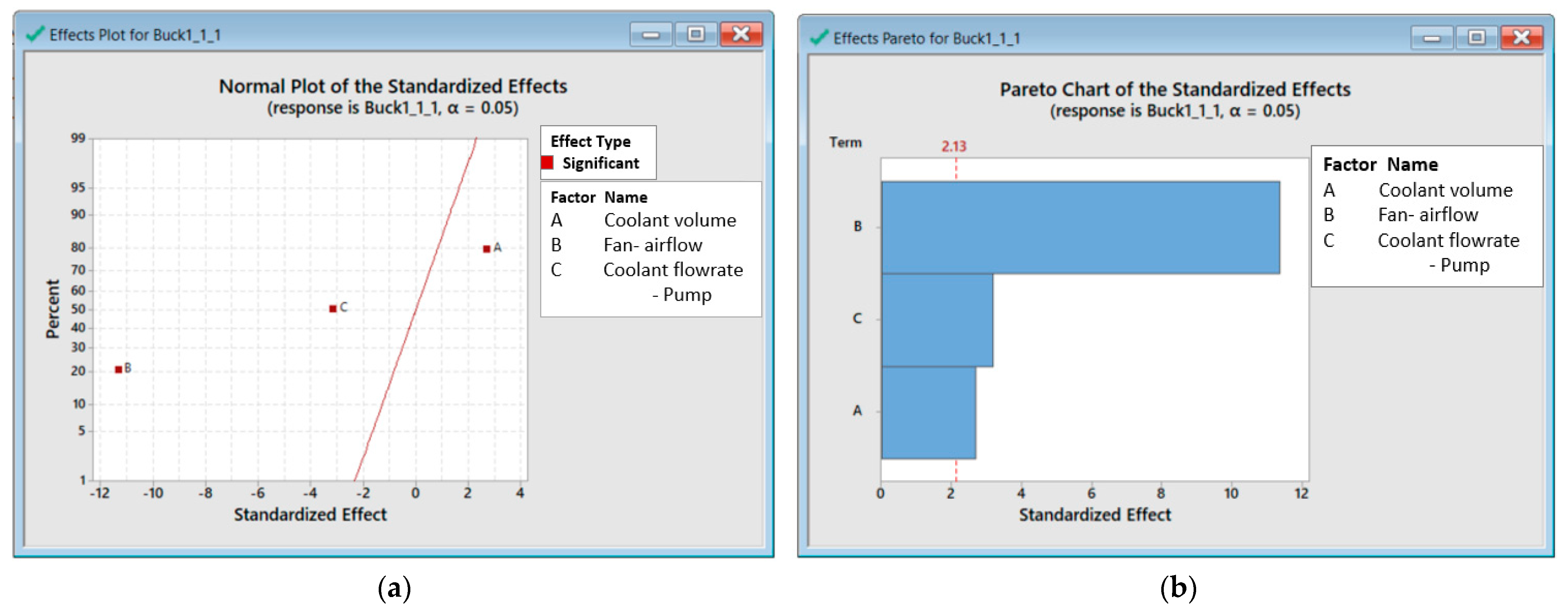
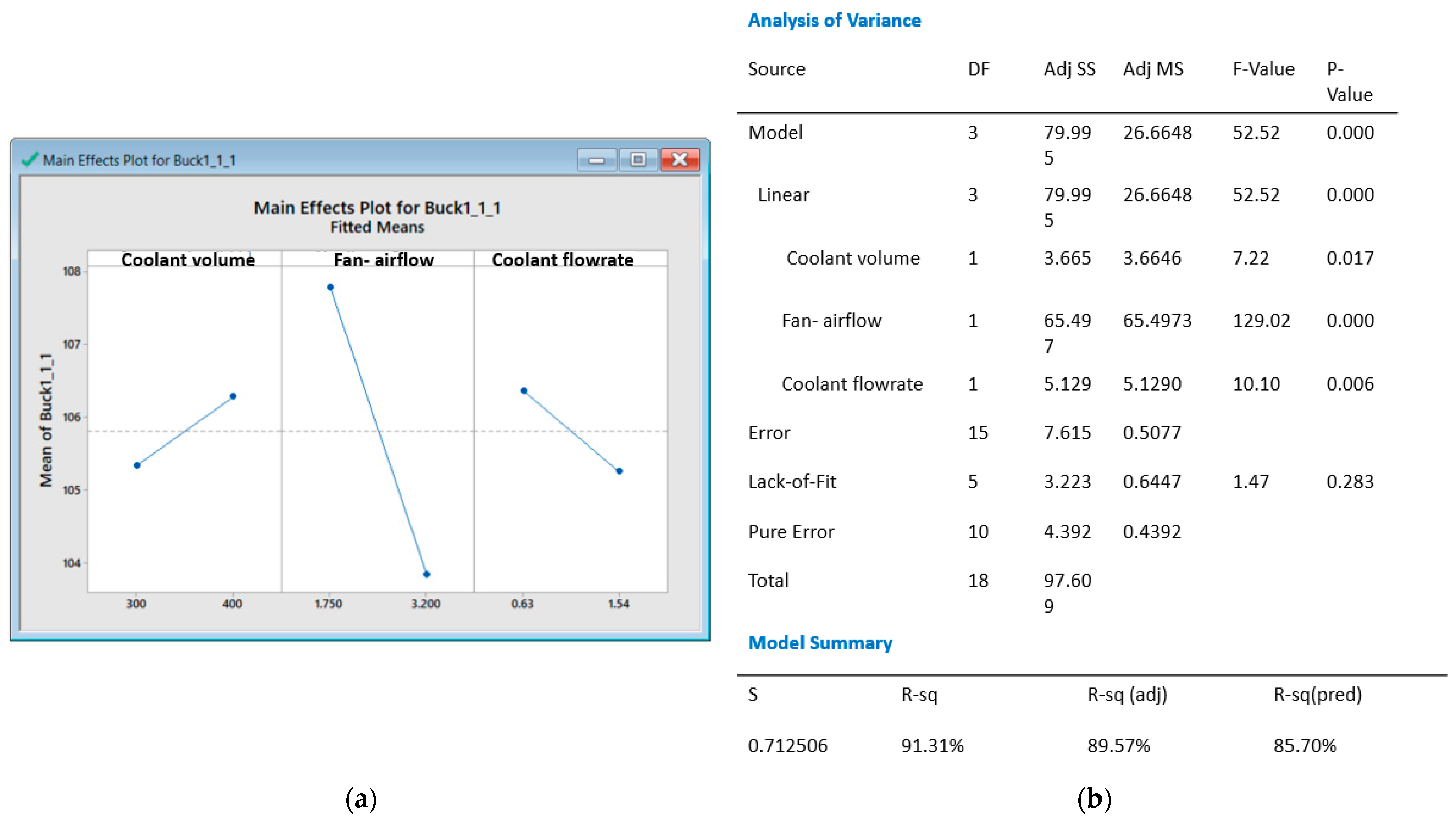
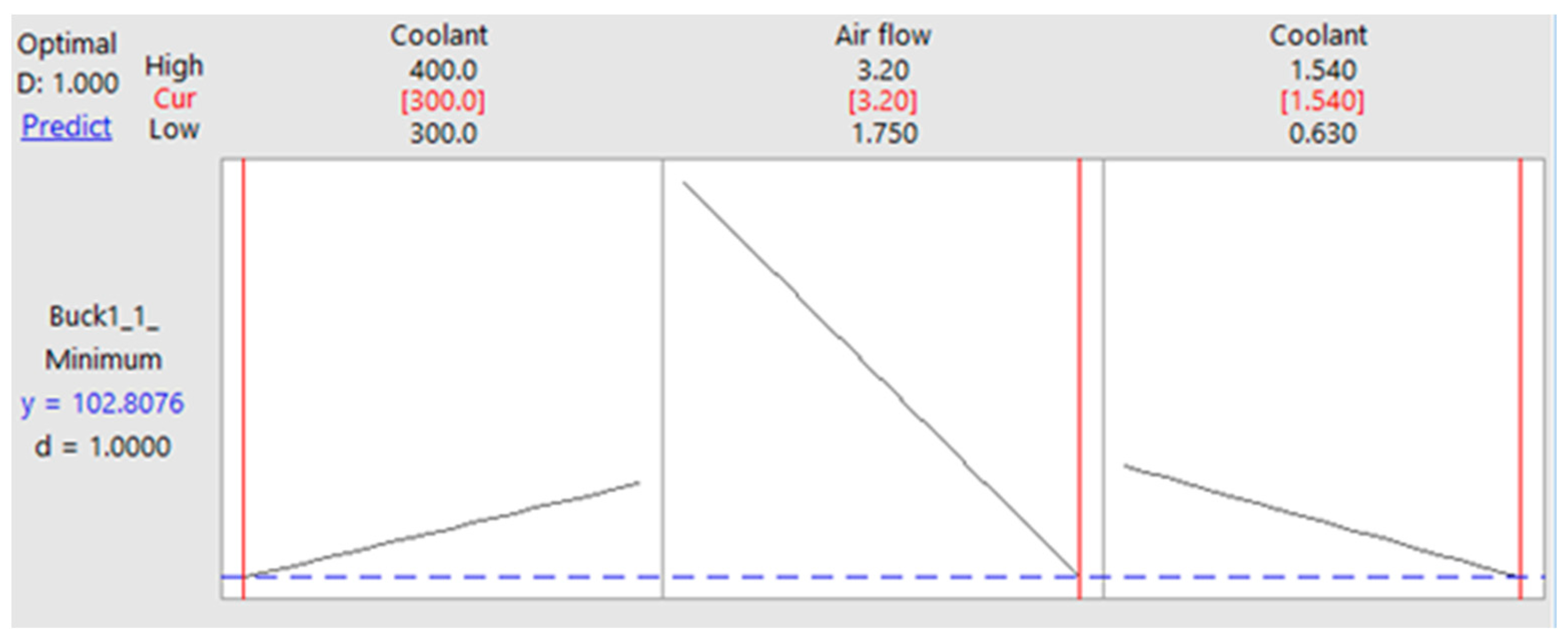
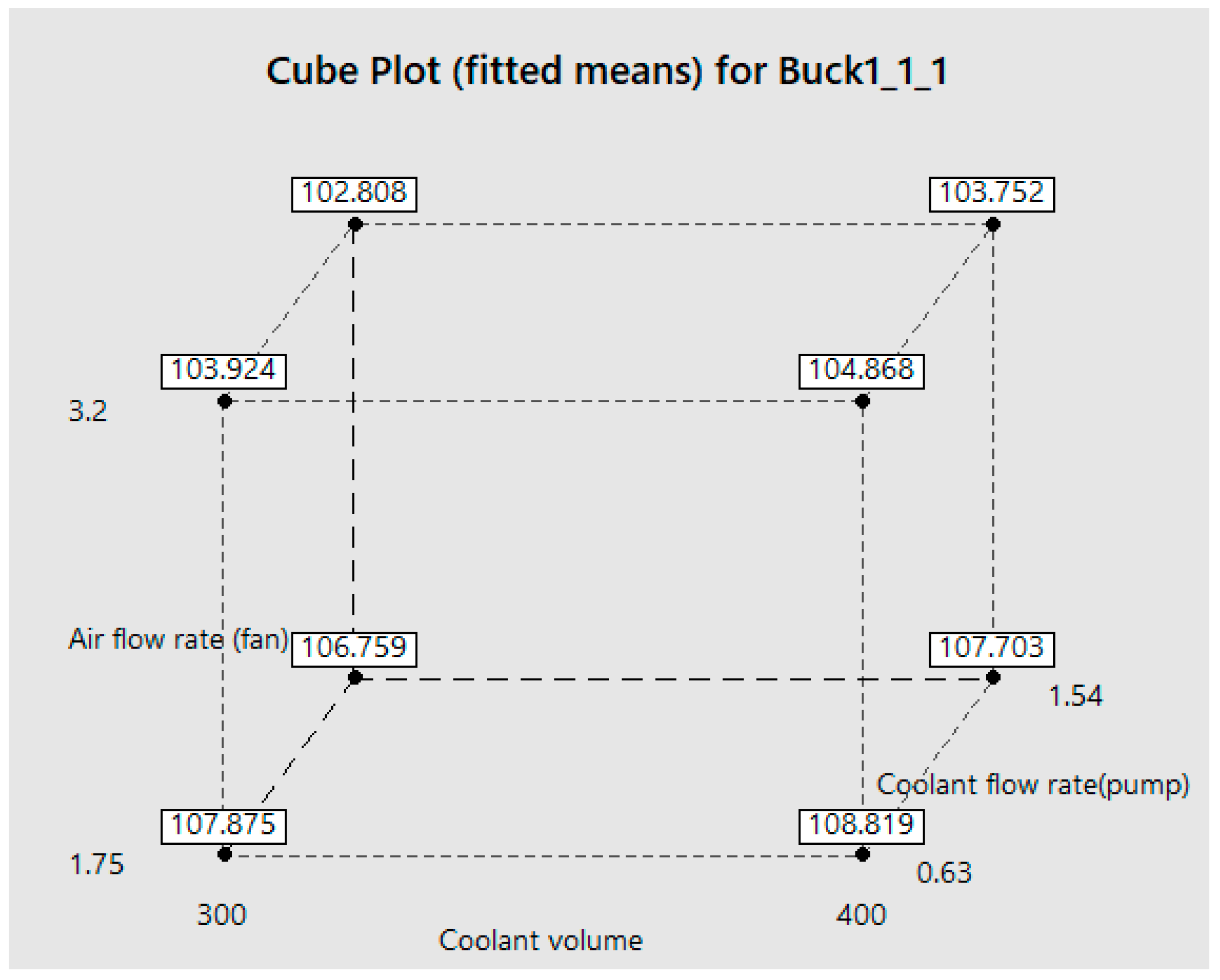
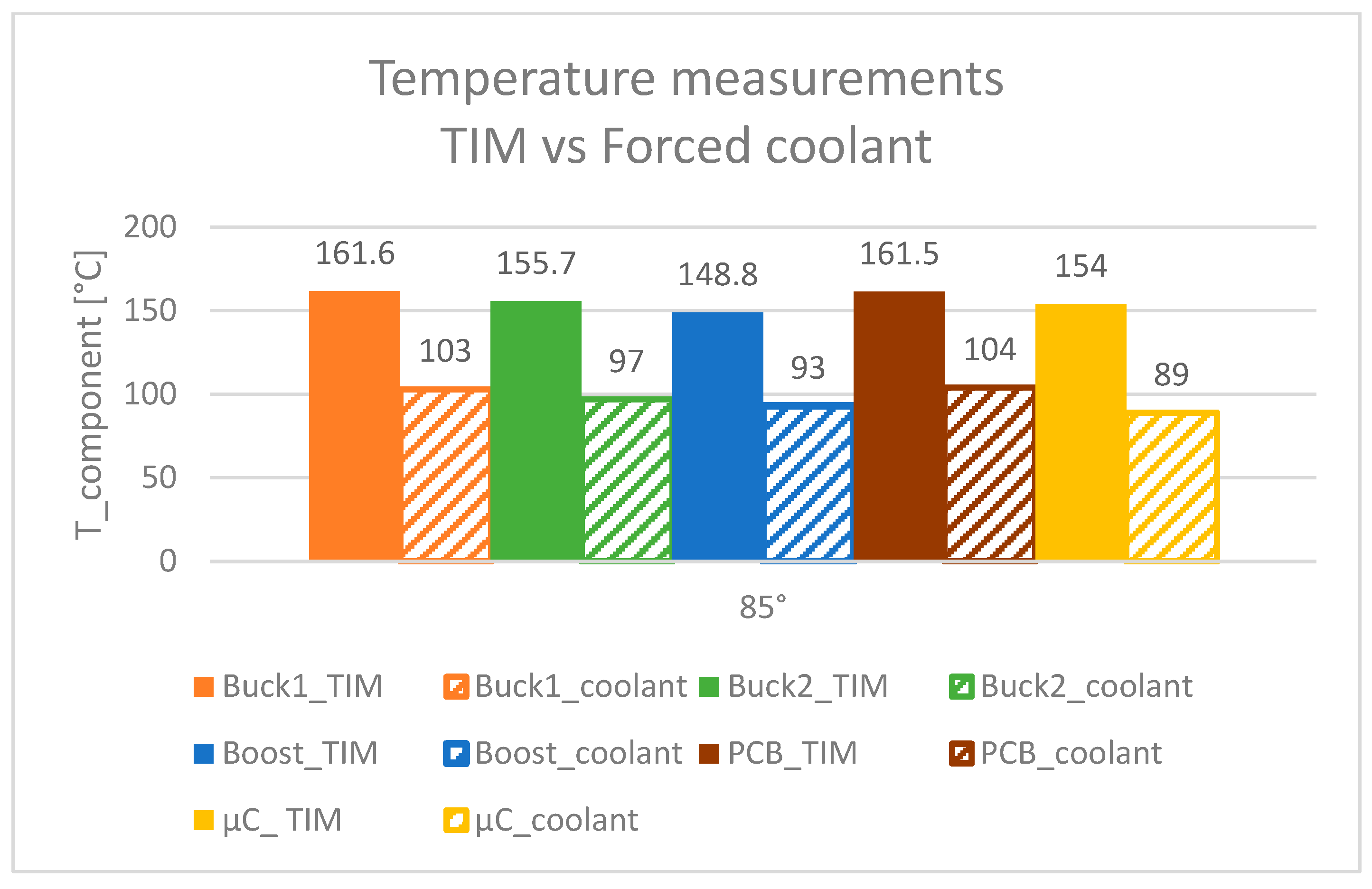
| Thermal Conductivity a [W/m·K] | Kinematic Viscosity b [mm2/s] | Heat Capacity [J/K·m3] | Density a [kg/m3] | Specific Heat [J/kg·K] | Coefficient of Expansion a [1/K] | Boiling Point [°C] | Pour Point [°C] | |
|---|---|---|---|---|---|---|---|---|
| SHC | 0.136 | 8.11 | 1,659,000 | 790 | 2100 | 0.00067 | >300 | −57 |
| TIM | 2 |
| Coolant Volume | Air Flow Rate (Fan) | Coolant Flow Rate | T_PCB | T_Boost | T_Buck1 | T_Buck2 | T_μC |
|---|---|---|---|---|---|---|---|
| 300 | 3.2 | 0.63 | 105 | 95 | 104 | 99 | 89 |
| 105 | 95 | 104 | 99 | 89 | |||
| 1.54 | 104 | 93 | 103 | 97 | 89 | ||
| 104 | 93 | 103 | 97 | 89 | |||
| 1.75 | 106 | 96.4 | 106 | 101 | 92 | ||
| 0.63 | 108.9 | 97 | 108 | 102.1 | 90 | ||
| 108 | 97 | 108 | 102.3 | 93.1 | |||
| 400 | 3.2 | 105.6 | 93 | 105.3 | 101 | 87.2 | |
| 106 | 93.4 | 105 | 99 | 89 | |||
| 105.8 | 93.7 | 105 | 99 | 88.4 | |||
| 1.75 | 1.54 | 106.3 | 98 | 109 | 103 | 93 | |
| 106.5 | 97.4 | 108 | 102.1 | 93 | |||
| 0.63 | 108 | 98 | 108 | 103.5 | 90 | ||
| 108.5 | 96.6 | 107.4 | 103.5 | 92 | |||
| 110 | 103 | 110 | 106 | 98 | |||
| 3.2 | 1.54 | 104.9 | 93.8 | 103.4 | 100 | 89.7 | |
| 104 | 93 | 102.9 | 97.7 | 89 | |||
| 350 | 1.085 | 0.91 | 106.20 | 97.00 | 106.00 | 99.00 | 90.00 |
| 106.80 | 97.00 | 106.00 | 99.00 | 90.00 |
Disclaimer/Publisher’s Note: The statements, opinions and data contained in all publications are solely those of the individual author(s) and contributor(s) and not of MDPI and/or the editor(s). MDPI and/or the editor(s) disclaim responsibility for any injury to people or property resulting from any ideas, methods, instructions or products referred to in the content. |
© 2023 by the authors. Licensee MDPI, Basel, Switzerland. This article is an open access article distributed under the terms and conditions of the Creative Commons Attribution (CC BY) license (https://creativecommons.org/licenses/by/4.0/).
Share and Cite
Lates, C.G.; Dumitras, C.G.; Vizureanu, P.; Sandu, A.V. Heat Transfer Optimization of an Electronic Control Unit Immersed in Forced Liquid Coolant. Appl. Sci. 2023, 13, 5310. https://doi.org/10.3390/app13095310
Lates CG, Dumitras CG, Vizureanu P, Sandu AV. Heat Transfer Optimization of an Electronic Control Unit Immersed in Forced Liquid Coolant. Applied Sciences. 2023; 13(9):5310. https://doi.org/10.3390/app13095310
Chicago/Turabian StyleLates, Cristina Georgiana, Catalin Gabriel Dumitras, Petrica Vizureanu, and Andrei Victor Sandu. 2023. "Heat Transfer Optimization of an Electronic Control Unit Immersed in Forced Liquid Coolant" Applied Sciences 13, no. 9: 5310. https://doi.org/10.3390/app13095310
APA StyleLates, C. G., Dumitras, C. G., Vizureanu, P., & Sandu, A. V. (2023). Heat Transfer Optimization of an Electronic Control Unit Immersed in Forced Liquid Coolant. Applied Sciences, 13(9), 5310. https://doi.org/10.3390/app13095310










